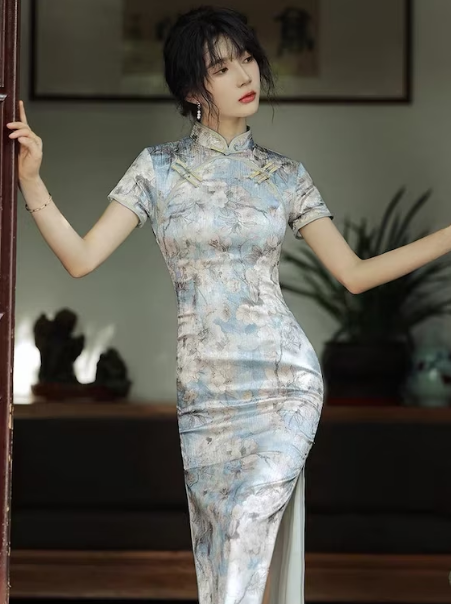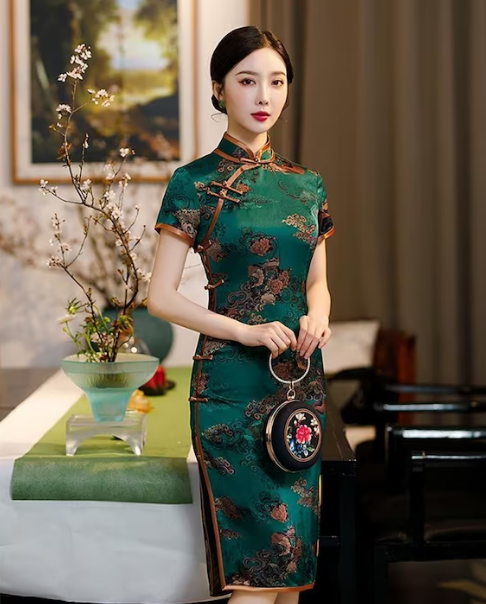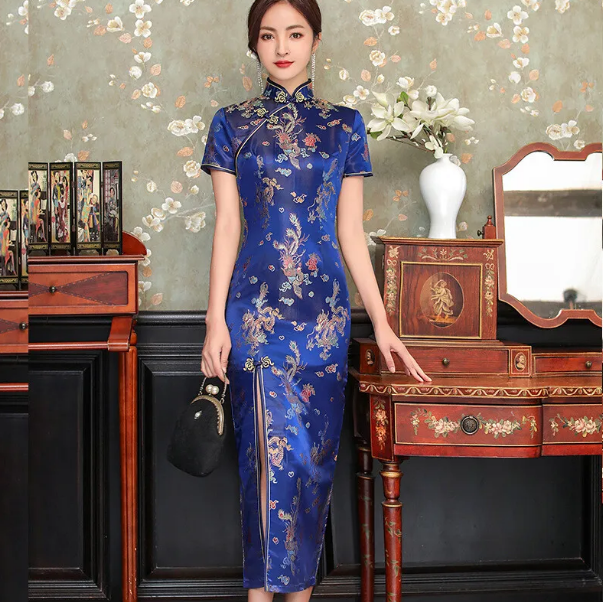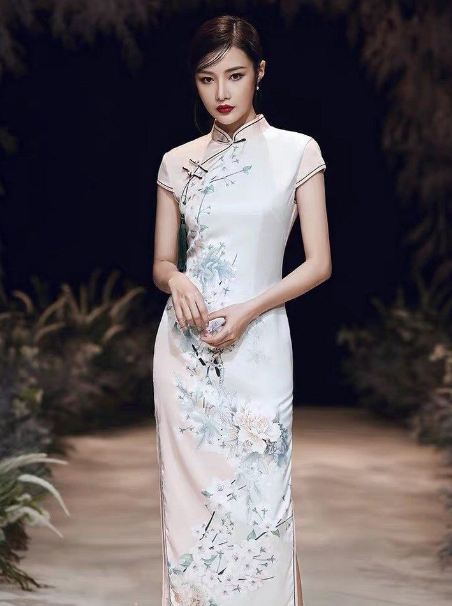Origins of the Cheongsam
The cheongsam, a traditional Chinese dress also known as “qipao” (旗袍) in Mandarin, has a fascinating history deeply intertwined with Chinese culture and fashion evolution.
Historical Development from the Qing Dynasty
The cheongsam traces its roots to the Qing Dynasty (1644-1912), specifically during the 17th century. At this time, it was initially known as the “qípáo” (旗袍). The Manchu people, who ruled China during the Qing Dynasty, significantly influenced its early designs.
The Manchu style, featuring loose robes over trousers, influenced the initial cheongsam design.
This loose-fitting design was practical for horseback riding, reflecting the nomadic heritage of the Manchu rulers.
As the Qing Dynasty progressed, so did the cheongsam. It gradually transformed from a loose-fitting garment to a more form-fitting and tailored dress. This transition allowed it to become a symbol of elegance and femininity.
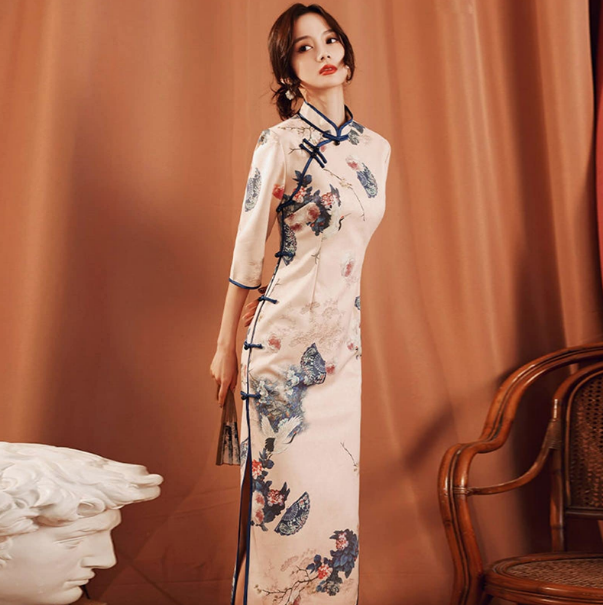
Manchu Influence on Early Designs
The Manchu influence on early cheongsam designs is evident in several ways. The dress initially had a high collar, a feature borrowed from Manchu robes. It also incorporated the use of intricate embroidery, which was a common element in Manchu clothing.
The materials used for the early cheongsam were often silk, satin, or brocade, emphasizing luxury and quality. These materials not only added to the aesthetic appeal but also contributed to the overall cost.
Transition to a Modern Silhouette
In the early 20th century, particularly during the 1920s and 1930s, the cheongsam underwent significant changes, marking a transition to a more modern silhouette.This transformation was influenced by the cultural and societal shifts in China during that period.
The modern cheongsam featured a body-hugging cut with a straight skirt, high side slits, and a more accentuated waistline. These changes highlighted the feminine form and elegance of the wearer.
The shift towards a modern silhouette made the cheongsam suitable for various occasions, from casual to formal, and contributed to its popularity not only in China but also on the international stage.
To learn more about the origins and history of the cheongsam, you can refer to the Wikipedia page on Cheongsam.
Evolution of Cheongsam Style
The evolution of the cheongsam style is a captivating journey through time, reflecting the fusion of traditional Chinese aesthetics and Western influences.
Influence of Western Fashion in the 1920s
The 1920s marked a pivotal era for the cheongsam as Western fashion trends began to intertwine with its traditional design.
- Western Influence: The 1920s saw a surge in Western-style fashion elements, with the cheongsam embracing elements such as shorter hemlines, low-cut collars, and a more streamlined silhouette.
- Materials and Embellishments: Western influences brought new materials like chiffon and lace into the design repertoire of the cheongsam, adding a touch of glamour.
- Iconic Features: The cheongsam of this period often featured high side slits, which not only showcased a woman’s legs but also made it easier to move, a practical consideration.
Iconic Features of 1930s Cheongsam
The 1930s marked a zenith in the cheongsam design, and several iconic features emerged during this period.
- Fitted Silhouette: The 1930s cheongsam was renowned for its body-hugging cut, accentuating the wearer’s curves and femininity.
- Exquisite Embroidery: Elaborate embroidery work became a hallmark of the 1930s cheongsam, with intricate motifs and patterns gracing the fabric.
- Elegant Accessories: To complete the look, women often paired their cheongsam with stylish accessories, including headdresses, gloves, and ornate hairpins.
Changes in Design and Materials Over Time
Over the years, the design and materials used for the cheongsam have evolved, reflecting changing fashion tastes and technological advancements.
- Design Adaptations: Modern iterations of the cheongsam have seen variations in collar styles, sleeve lengths, and necklines to cater to different occasions and preferences.
- Materials: While silk remains a preferred choice for many traditional cheongsam, contemporary versions have embraced a wider range of materials, including satin, velvet, and even synthetic fabrics.
- Quality and Craftsmanship: The quality of the cheongsam is often determined by the craftsmanship and the attention to detail. High-quality cheongsam are often hand-stitched with meticulous care.
The evolution of the cheongsam style showcases its adaptability and enduring appeal, making it not just a fashion statement but also a symbol of cultural heritage.
For more detailed information and references, you can explore the Wikipedia page on Cheongsam.
Cultural Significance of the Cheongsam
The cheongsam holds a profound cultural significance in China, reflecting its pivotal role in various aspects of Chinese traditions, ceremonies, and cultural identity.
Role in Chinese Traditions and Ceremonies
The cheongsam is an integral part of numerous Chinese traditions and ceremonies, playing diverse roles:
- Weddings: In Chinese weddings, the bride often wears a red cheongsam as a symbol of happiness and good fortune. Red, an auspicious color in Chinese culture, is believed to ward off evil spirits.
- New Year Celebrations: During Chinese New Year, it’s common for people to don new clothes, and the cheongsam is a popular choice for both adults and children. It symbolizes renewal and fresh beginnings.
- Tea Ceremonies: In traditional Chinese tea ceremonies, women may wear the cheongsam, signifying respect for the time-honored rituals.
- Festivals: During cultural festivals like the Mid-Autumn Festival or the Lantern Festival, women may wear specially themed cheongsam to celebrate these occasions.
Symbolism and Cultural Identity
The cheongsam serves as a symbol of Chinese cultural identity:
- National Pride: It is considered a representation of Chinese heritage and is worn with pride during international events, such as the Olympics, where Chinese athletes may sport cheongsam-inspired uniforms.
- Cultural Heritage: The intricate designs, motifs, and embroidery on the cheongsam often reflect regional cultural elements, showcasing the diversity and depth of Chinese culture.
- Revival and Preservation: Efforts have been made to preserve and promote the traditional cheongsam as a valuable cultural artifact, emphasizing its unique place in Chinese history.
Popularity During Festivals and Celebrations
The cheongsam experiences heightened popularity during festive occasions:
- Chinese New Year: Families gather to celebrate wearing matching or coordinated cheongsam, creating a sense of unity and tradition.
- National Holidays: On significant national holidays like the Dragon Boat Festival or National Day, you can observe people of all ages donning their best cheongsam attire.
- Cultural Performances: In traditional Chinese dance and music performances, the cheongsam is often the preferred costume, adding elegance to the show.
The cheongsam‘s enduring popularity during festivals and celebrations underscores its timeless appeal as a cultural icon.
For more information on the cultural significance of the cheongsam, you can refer to the Wikipedia page on Cheongsam.
Regional Variations
The cheongsam, as a symbol of Chinese fashion, exhibits diverse styles across different Chinese regions, reflecting the influence of regional cultures and aesthetics.
Diverse Styles Across Different Chinese Regions
China’s vast landscape and rich cultural heritage have given rise to a wide array of regional cheongsam styles, each with its unique characteristics:
- Shanghai Style: The Shanghai cheongsam, known for its elegance, typically features a figure-hugging silhouette, high collars, and exquisite embroidery. It is considered one of the most iconic variations.
- Cantonese Style: In southern China, particularly in Guangdong province, the cheongsam is known for its vibrant colors, intricate patterns, and shorter length, allowing for ease of movement.
- Beijing Style: The Beijing cheongsam tends to be more conservative, with a loose fit and simple designs. It often emphasizes comfort and functionality.
- Hakka Style: Among the Hakka ethnic group, the cheongsam features distinctive colors and patterns, showcasing the cultural identity of the Hakka people.
Influence of Regional Cultures and Aesthetics
- Cultural Heritage: Historical and cultural factors play a significant role. For instance, the Shanghai cheongsam reflects the city’s cosmopolitan history, while the Cantonese cheongsam embodies the vibrancy of southern China’s culture.
- Climate and Geography: Regional climate and geography also impact design choices. Southern styles prioritize comfort and breathability, while northern styles may focus on warmth and insulation.
- Local Craftsmanship: Local artisans and craftsmen contribute to the cheongsam‘s regional variations, showcasing their skills and creativity through embroidery, fabric selection, and detailing.
Notable Variations and Design Elements
- Collar Styles: Collar designs can vary from high mandarin collars in Shanghai to shorter, more casual collars in Guangdong.
- Sleeve Length: Some regions prefer long sleeves, while others opt for short sleeves or sleeveless designs.
- Color Palette: Regional preferences for colors differ, with vibrant reds and blues in southern China and more muted tones in the north.
- Embellishments: Different regions incorporate unique embellishments such as beadwork, floral patterns, and motifs inspired by local traditions.
The rich tapestry of regional cheongsam styles serves as a testament to China’s cultural diversity and heritage, making it a dynamic and ever-evolving fashion icon.
For more information on regional variations of the cheongsam, you can explore the Wikipedia page on Cheongsam.
Cheongsam in Contemporary Fashion
The cheongsam, a traditional Chinese dress, has evolved to attain global appeal, gaining international recognition for its unique blend of tradition and modernity.
Global Appeal and International Recognition
The cheongsam has garnered worldwide recognition for its timeless elegance and cultural significance:
- International Events: The cheongsam is frequently worn by Chinese delegations at international events like the Olympic Games and cultural expos, showcasing its role as a symbol of Chinese identity on the global stage.
- Fashion Shows: Renowned fashion designers around the world have incorporated elements of the cheongsam into their collections, introducing it to a global audience.
- Celebrities: Celebrities and fashion icons often choose to wear the cheongsam on red carpets and in high-profile events, generating significant media attention.
Modern Adaptations and Variations
Contemporary adaptations have revitalized the cheongsam:
- Innovative Materials: Modern cheongsam makers now use a wide range of materials, including silk blends, brocade, and even eco-friendly fabrics, expanding its versatility and appeal.
- Fusion Styles: Designers have experimented with blending traditional elements with Western fashion trends, creating fusion cheongsam styles that cater to diverse tastes.
- Customization: Tailors offer customizable options, allowing individuals to choose specific colors, embellishments, and design features to suit their preferences.
Role in the Fashion Industry Today
The cheongsam continues to play a significant role in the contemporary fashion industry:
- Special Occasions: Women still choose the cheongsam for special occasions like weddings, formal banquets, and cultural celebrations due to its timeless charm.
- Runway Appearances: The cheongsam makes regular appearances on international runways, influencing fashion trends and inspiring designers globally.
- Cultural Exchange: The cheongsam has become a symbol of cultural exchange, fostering a deeper appreciation of Chinese fashion and heritage worldwide.
The modern cheongsam exemplifies the blending of tradition and innovation, emphasizing its enduring relevance and contribution to the global fashion landscape.
For more information on the contemporary role of the cheongsam in fashion, you can explore the Wikipedia page on Cheongsam.
Debates and Challenges
The cheongsam, despite its enduring popularity, has sparked debates and encountered various challenges in the contemporary world.
Cultural Appropriation vs. Appreciation
Cultural Appropriation and Cultural Appreciation debates surround the global adoption of the cheongsam:
- Cultural Appreciation: Many argue that wearing the cheongsam can be a form of appreciating Chinese culture, acknowledging its rich history and traditions.
- Cultural Appropriation: Critics raise concerns about the potential misuse or misrepresentation of the cheongsam, especially when worn by individuals not from Chinese backgrounds.
Changing Perceptions and Controversies
The cheongsam has been at the center of changing perceptions and controversies:
- Controversies: Instances of public figures wearing the cheongsam inappropriately or insensitively have triggered controversies and discussions about cultural sensitivity.
- Empowerment: Some view the cheongsam as a symbol of empowerment for women, while others argue that it can perpetuate traditional gender roles.
Efforts to Preserve and Promote Traditional Cheongsam
- Cultural Institutions: Museums and cultural institutions in China and abroad curate exhibitions to showcase the historical and artistic value of the cheongsam.
- Education and Awareness: Educational initiatives aim to raise awareness about the cheongsam’s cultural significance, fostering a deeper understanding of its role in Chinese heritage.
- Supporting Artisans: Initiatives to support traditional artisans and tailors who create authentic cheongsam garments help preserve traditional craftsmanship.
- Legislation: In some cases, legislation has been proposed or enacted to protect the traditional design of the cheongsam from imitation and misuse.
Balancing cheongsam debates in today’s society requires cultural sensitivity and preservation.
For more information on the debates and challenges related to the cheongsam, you can explore the Wikipedia page on Cheongsam.
